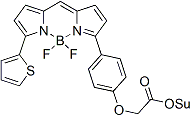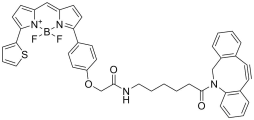BDP TR is a bright boron-dipyrromethene dye for ROX channels. It is an alternative to ROX and Texas Red. ROX and Texas Red dyes oxidize easily, BDP TR is more resistant to oxidizing agents. Its brightness and light stability are also very high. Such amine derivatives can be used in conjugation with electrophiles such as epoxides and activated carboxyl derivatives, as well as in enzymatic transamination reactions.
BDP TR
DP TR: Spectral Properties and Applications
BDP TR (Boron-Dipyrromethene Texas Red) is a bright red fluorescent dye renowned for its excellent photostability and high fluorescence intensity. It is widely used in fluorescence microscopy, flow cytometry, and FRET due to its strong signal and well-defined spectral characteristics.
Spectral Properties of BDP TR:
- Absorption Maximum: ~589 nm
- Emission Maximum: ~616 nm
- Stokes Shift: ~27 nm
- High Quantum Yield: Provides intense and efficient fluorescence, suitable for high-sensitivity detection.
- Photostability: BDP TR resists photobleaching, ensuring consistent fluorescence during extended imaging.
- Sharp Spectral Peaks: Narrow absorption and emission spectra minimize overlap, improving signal clarity in multiplex assays.
Applications of BDP TR:
- Fluorescence Microscopy: Ideal for visualizing cellular structures and monitoring dynamic processes with high resolution.
- Flow Cytometry: Used for clear and distinct cell sorting and analysis.
- FRET Studies: Effective in FRET assays for studying molecular interactions and conformational changes.
- Molecular Labeling: Suitable for labeling proteins, nucleic acids, and other biomolecules in diverse biological applications.
BDP TR’s combination of bright, stable fluorescence and sharp spectral properties makes it a reliable choice for researchers needing high-precision fluorescent labeling and detection in various scientific studies.




